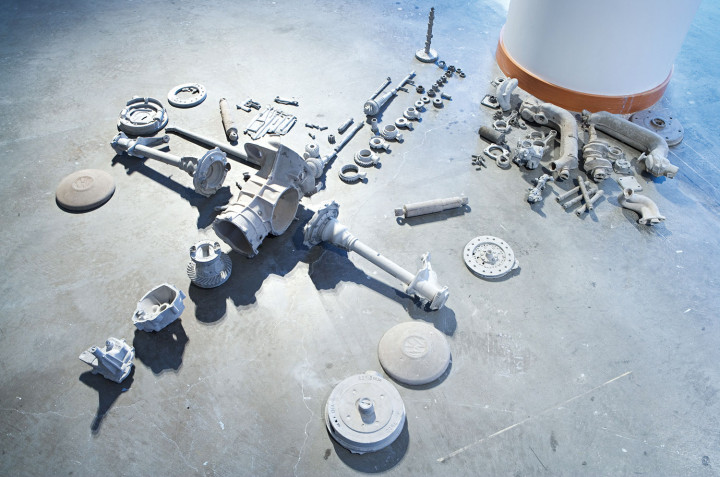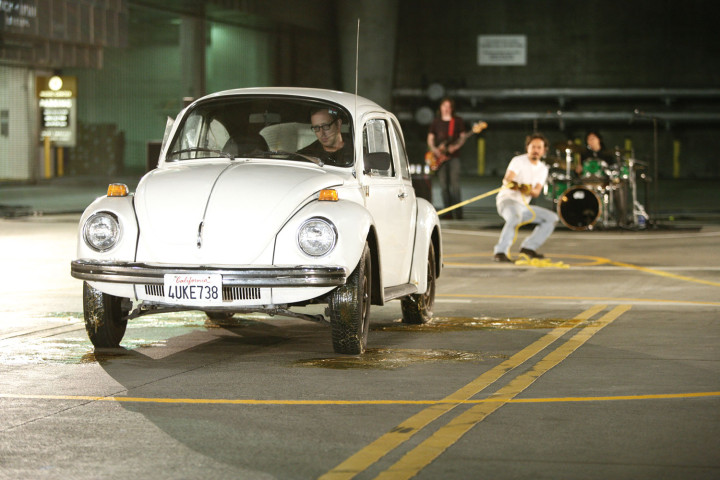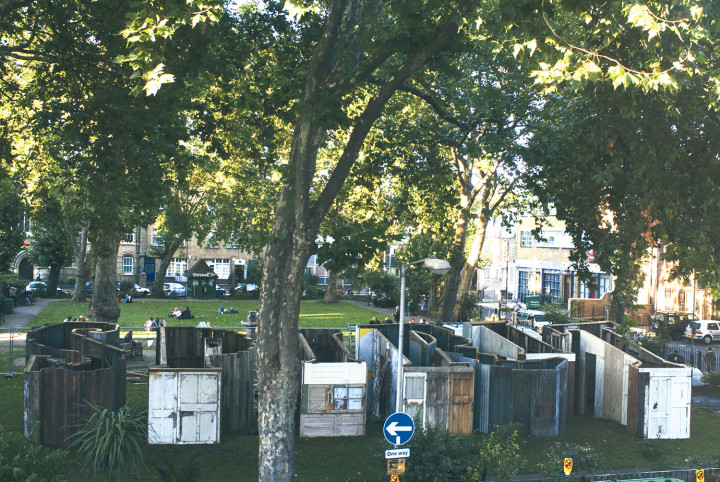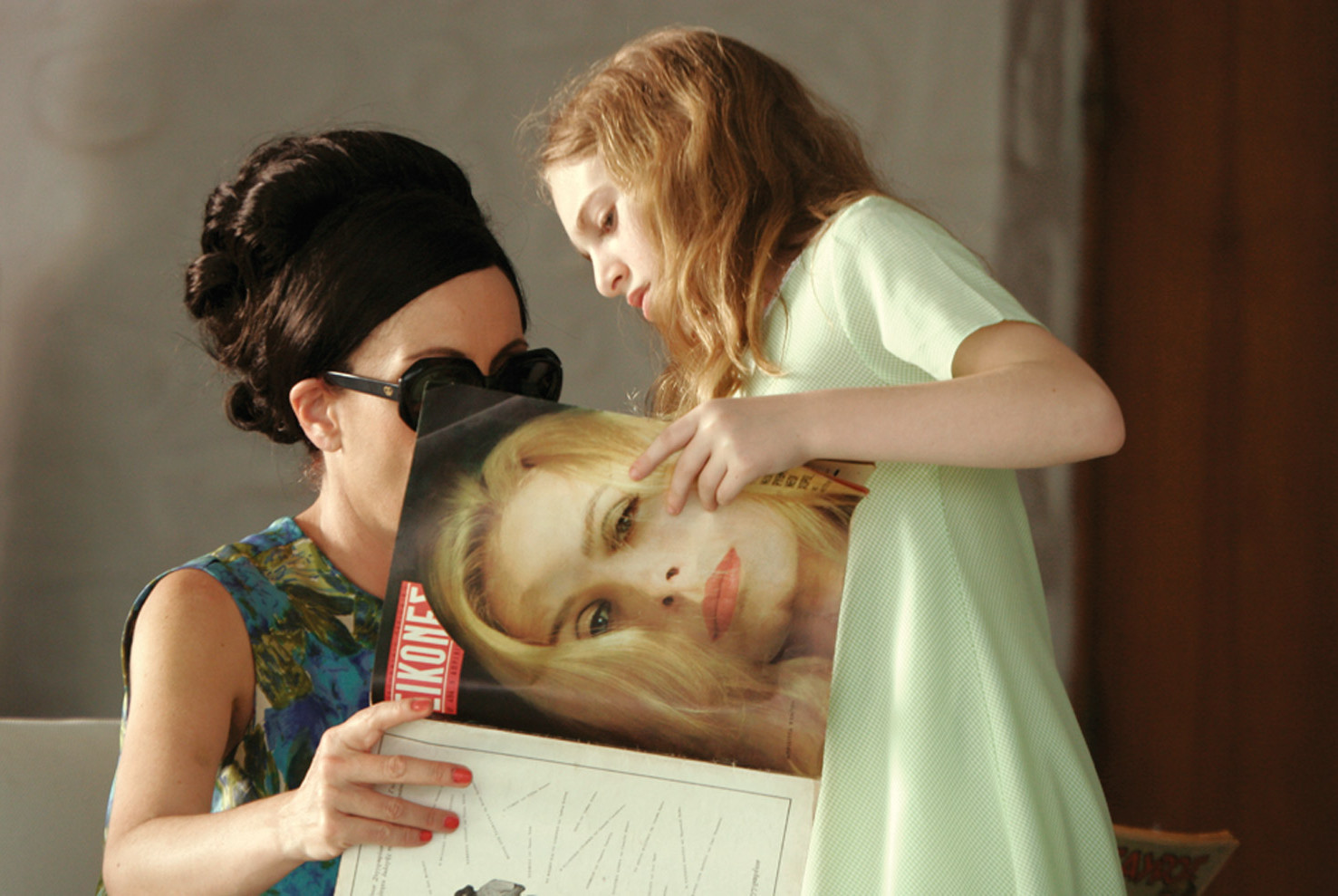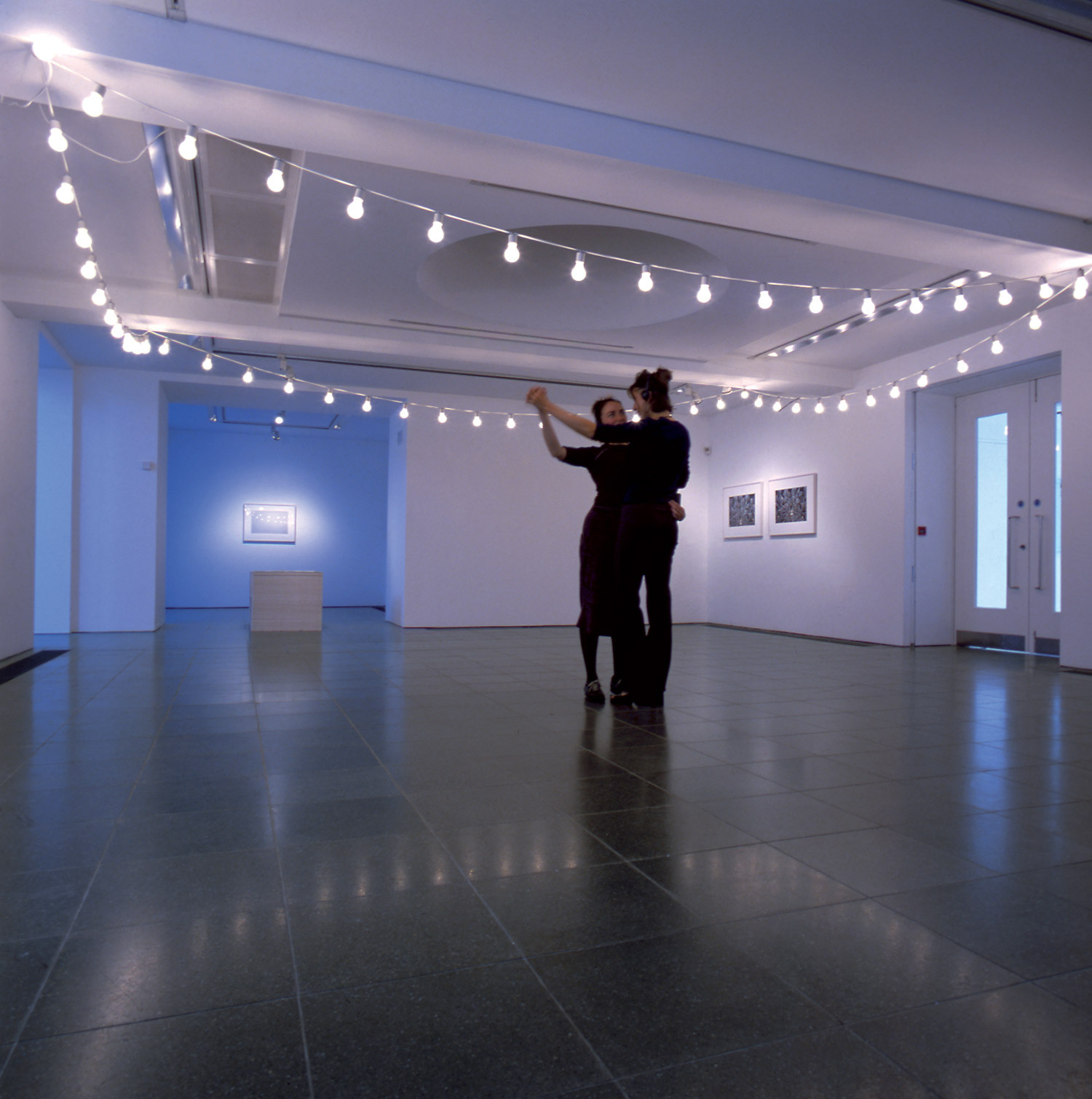
Damián Ortega makes sculpture with different techniques and materials, and with a special interest in creating ‘new engineering’ for preexistent objects, places and situations. This analytical aspect of his work could be called ‘poetic actionism,’ with a particular inclination towards disassembling objects, suggesting an inherent movement.
Ortega is part of a group gravitating around Kurimanzutto, a gallery that exhibits artists that have been working together since the 1980s, when they joined together to follow Gabriel Orozco’s workshop. Ortega created for the gallery Moby Dick, an action performed in a parking area in Mexico City in 2004, consisting of a car driven by a stuntman and restrained by many people holding ropes tied to it while a rock band played Led Zeppelin. This performance is part of a trilogy — including also Cosmic Thing (2002) and Beetle ’83, Escarabajo (2004-05) — presented last November at REDCAT and MOCA in Los Angeles. In Mexico City he also designed the architecture that hosted the group show “Elephant Juice” (2003), a labyrinth made of a modular metallic structure.
Last year Ortega spent some time in Rio de Janeiro where he developed a series of pieces that reacted to the Brazilian context: informal architecture as in Matéria em Repouso, where heaps of bricks create irregular forms; art history as in Futebol Neoconcreto, where he merges Lygia Clark’s paintings to soccer game panels. At Museu de Arte da Pampulha in Belo Horizonte, he created the site-specific work Ordem, Réplica, Acaso that takes after the architecture of Oscar Niemeyer’s Casino (1940-43). Inspired by the mirror-covered wall of the building’s grand salon, the artist built three-dimensional replicas of the wall made of stainless steel sheets simulating the same dimensions and colors of the mirror panes. The piece is composed of 24 cubes, progressively scattered, that deconstruct the building architecture as if the mirrors reproduced themselves ad infinitum.
More recently, Ortega performed two projects in relation to the representation of space, at the Kunsthalle Basel in Switzerland and at the White Cube Gallery in London. In Basel, he showed two sculptures, one the extension of the other: Clay Mountain (2004), a mountain of pure clay with its scatological suggestions, and Iglesia en Rotación (2004), where a series of bricks drew on the floor a schematic plan of a church, suggesting a “caricature of a religion.” The project at White Cube, titled Spirit and Matter (2004), made reference to the legendary Will Eisner’s comic book character The Spirit, a masked crime fighter. The piece, installed in Hoxton Square, recalled Hélio Oiticica’s Penetráveis [Penetrables] and could be passed through by the viewer. Each construction, built with used material taken from doors and windows, formed the shape of a letter in the word ‘spirit,’ which in the comic was drawn differently each time; the whole installation could be seen in its entirety only from the second floor of the gallery. The work focused on the ideas of representation and physicality, illusionism and image. — Rodrigo Moura
Rodrigo Moura: Let’s start from the beginning. How did you get involved with art? I know of your long experience working with an artists’ community in Mexico City…
Damián Ortega: At the age of 16 I went to the university, but there was nothing that I wanted to follow there. So I decided that I had to find a teacher. That took some time, but then one day my brother said, “A friend of mine, Gabriel Orozco, has come back from Spain and he has some new ideas.” I went to look for him and I told him that I wanted to learn painting — I wanted to be a muralist. At the same time, I started following a workshop in political caricature because I wanted to have this background for making mural paintings. I was interested in political art but also in painting. Other friends, such as Gabriel Kuri and Abraham Cruzvillegas, joined us and we organized a workshop that lasted many years. We worked and came together to discuss each other’s ideas. That was the beginning. From that moment on I started to understand painting as an object, and to make objects and installations. We became involved in Orozco’s mental processes.
RM: You dedicated yourself professionally to cartoons. What is the importance, for you, of historical symbols of Mexican graphic art such as Posada or the Taller de Gráfica Popular [Workshop for Popular Graphic Art]?
DO: I worked at newspapers and magazines such as La Jornada, which is left-oriented and has an important role in social movements. I stopped with that because little by little my political position was becoming the publication’s position and no longer my own subjective and critical point of view. But I’ve always thought that the history of caricature in Mexico is more interesting than the history of painting. Distributing political art by means of cartoons is a tradition that has strongly influenced contemporary notions of art. Posada interests me more than Méndez [founder of the Taller de Grafica Popular]. I’ve always admired him as a popular artist and portraitist.
RM: Today, what is the connection between your work as a sculptor and as a caricaturist?
DO: It’s the idea of a site and time specific to the creation of a work. An image doesn’t say the same thing one day as it does on another, or in one place as it does somewhere else. I often noticed coincidences between these two languages, sculpture and caricature, because of the political aspect that can exist in both of them.
RM: Your sculptures don’t simply exist as static objects but seem to suggest a certain motion, an activity — something less static than traditional sculpture and closer to comics and cinema.
DO: I really like when in comics a character is depicted with the eyes coming out of their face. It articulates a closed object that smashes up, caricatured in a process. Cutting can be a way of understanding an action or phenomenon, like the work in which the church makes itself disjointed (Iglesia en Rotación, 2004). It is an animation or the history of a movement such as we might see in cartoons. There is a sense of humor in pieces like Pico Cansado [Tired Pickax] from 1997, whereby the cable is a flexible spinal column. You can see it as a caricature of force or as a satire of the work itself.

RM: You work with a wide range of materials — not only with existing objects and elements that you appropriate, like the Coke bottles in 120 Jornadas (2002), but also with materials in raw states such as the heap of clay in Clay Mountain (2004).
DO: I have no material worries, just formal ones. I have never thought about working with glass for example. I found a Coke bottle and it is not the glass that interests me but the fact that it is a Coke bottle. I don’t care about the materials; they can be ephemeral, like tortillas, or solid, like concrete.
RM: What is sculpture for you?
DO: I’ve always defined my work as sculpture, more than installation or anything else. What interests me is the sculptural connection. For example, the Moby Dick action is a game of tensions, of balance and of strength. I like conceiving sculpture as a relation of forces, resistance, balance and gravity. I like to think that it is related to magic and to engineering. Even a dam or a bridge interest me…
RM: …as in the “The Beetle Trilogy,” in which there are three possible readings of the same object. In it you created a dialectical passage between one work and the other. One with the latent raw material, the pure clay, and another with the same material in another state, used constructively to make a very recognizable form. The idea was that people would take the clay and throw it against the wall…
DO: I wanted to arouse this ‘brutal’ side of the people. When I got to the place and I saw everything so white, clean and recently made, I thought, “I feel like dirtying this place up!” I wanted to offer something that was not yet developed. And in the next room, there was a cold, dry city, built with bricks that create a construction on a 1:1 scale. These spaces could be residential places — each of them could be an apartment. To have something consolidated and something unstable in the same exhibition was something that interested me. With the church sculpture (Iglesia en Rotacion, 2004) I wanted to comment on the idea of the center. But the center doesn’t exist: it is a process. In the history of architecture, they always used to talk about the church as a way that leads to God, to the truth. The relationship with it is not regular, but rather labyrinthine. It is a temporary center, one that is constantly changing location.
RM: Your church, with its architecture strongly based on a model, has its truth based on a process that is necessarily relative.
DO: Yes, even the church, which is a fixed point of reference that is stable, turns out to be relative. The piece is a caricature of religion and of the idea of stability.
RM: Tell me about your interest in architecture.
DO: I am not interested just in architecture. I feel more connected with engineering — with engineering and with ‘nonformal’ architecture, in the sense that it is not made by architects.
RM: You have been working with organic and apparently chaotic destabilizations of canonical forms, as can be seen in your sculptures based on housing units (Conjunto Habitacional, 2000) and on the shape of the cube (Cubo Negro, 2003, and Ordem, Réplica, Acaso, 2004)…
DO: In these works what interested me was the cube as the archetypal form at the base of the minimalist investigation. As with the car of Cosmic Thing, the cube is divided and also fragmented, creating organic or irregular structures. I was interested in revealing the internal logic of the cube — inside the cube there is another cube. With Ordem, Réplica, Acaso I was captivated by the place. The wall, which is entirely built from squares, could turn into a cube structure. I thought that it would be interesting to destroy the wall and take it to the ground, as a way of deconstructing the space.

